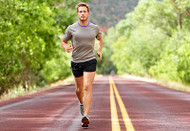Expert Guide to Buying the Right Running Shoes for Any Terrain in 2023
Posted by Cara Spindler on Jun 10th 2023
Expert Guide to Buying the Right Running Shoes for Any Terrain in 2023

By CARA SPINDLER
Nothing is better than trying to improve ourselves by creating a healthier lifestyle. And while many Americans have always chosen running as a way to keep fit, millions of others have just recently turned to running for the very first time, as a way to become pro-active about their health and well-being.
The Impact of the 2020 Lockdowns
During the lockdowns that occurred in 2020, the number of adults who took up running increased substantially. More than 50 million Americans participated in running or jogging activities in 2020, with approximately 28.7 % of all runners having been novices who had enthusiastically taken up the sport. And while this is a good thing, it has adversely impacted the running shoe industry; affecting the supply and demand of running shoes.[1] by creating a scarcity in materials, labor and transportation.
Experienced runners already know how important a good running shoe is to their gait and endurance. Not just for comfort on long runs, but for how the sneakers work with the biomechanics of their feet. Stride length and foot strike matter, both independently and when coupled together [2], as does the shoe's minute details, right down to the millimeter of the Heel-Toe Drop of their shoes. Newer runners need to learn the basics of how to buy the right pair of running shoes.
How to Determine Your Run Pattern
Many runners are able to discover their arch type by visiting a local shoe store and standing on a machine that provides feedback on the structure of their feet. Alternatively, you could step into a puddle of water and then start to walk on cement. The footprints left behind will indicate the height of the arch of your feet.

This is important because the height of the arch correlates to the Pronation/Supination of the foot when you are running. Pronation is the impact of your weight distribution with each step, regarding the amount of inward rolling that occurs. Supination (under-pronation) is when your weight goes to the outside of your foot as it lands, causing you to push off with your toes instead of your heels.
"There is a natural degree of pronation as the foot moves through the different phases of weight-bearing during normal gait." {3}
 Your gait pattern can be determined by looking at the worn areas on the soles of your sneakers.
Your gait pattern can be determined by looking at the worn areas on the soles of your sneakers.
- Over-Pronators
Wear will show on the inside of the heels of your outsoles, as well as under the area around the balls of the feet just under the area of your biggest toes.
. - Neutral Pronators
Your gait will show to be well-balanced and you will not see any excessive wear in any one particular area.
. - Under-Pronators (Supinators)
Wear will appear along the outside edges of your shoes.
Where the Rubber Meets the Road
Choose the Right Running Shoes for the Right Terrain
In the mid 60's the Firestone Tire company used the phrase "Where the Rubber Meet the Road" in their advertisements to emphasize the importance of traction, as it exists between an automobile and its tires and the road.
Considering that your body is your vehicle through life, this phrase can also signify the importance of the traction that exists between your body and your feet and the terrain you run on.
Therefore you need to know how to chose a pair of running shoes that will provide you with the right features for the terrain you will be running over, so you can perform at your level best on each and every run..
Best Trail Running Shoes

Trail Running Shoes have a lot of technology built into them to endure the terrain and the natural outdoor elements you will encounter on your off-road adventures. They will traditionally have less padding and thicker outsoles than road-running shoes, because the ground is more forgiving on nature's trails, than on a hard-packed road. The thicker outsoles are there to protect your feet from any rough impacts, such as when running over rocks and hard tree roots.
Due to the variety of inclines you will encounter while trail-running, it is important to choose shoes with a deep multi-directional tread. This type of outsole will provide you with the rugged
dig-in grip needed to ascend upwards on the trail, as well as the reverse dig-in grip for slowing you down or for sudden stopping on a downward incline. These deeper lugs also will help secure your footing when running through an unseen patch of mud, or when venturing over slick, wet trails.
For trail-running, select a stabilizing shoe that is a bit more rigid in structure to prevent your feet from twisting or torqueing on uneven terrain. The combination of grippy, lugged outsoles and built in stabilized frames will also help to prevent injury when running over loose dirt, rocks and plant debris along the way.
Best Waterproof Trail Runners

Waterproof Trail Runners will have all the attributes of a pair of trail running shoes, but with the added benefit of having a waterproofed layer built-in. This unseen layer should withstand running in the rain, crossing streams, or just splashing through unexpected puddles along the way.
Waterproof Membranes should be seamlessly built into the uppers of the shoes to prevent any rubbing or discomfort. In fact, it should not even feel like the membranes are even there. Runners having moisture wicking liners and fast-shedding technology will help allow the shoes to dry off fast and to keep you unstoppable on your run.
Best Long Distance Running Shoes for Marathon and Cross-Country Runners

Long Distance Runners have it easy. When it comes to running a half or a full Marathon, it only comes down to 3 things: comfort, comfort, comfort
Since preventing foot fatigue and avoiding foot pain are key to getting over the finish line, lightweight shoes are the wisest choice because they will not slow you down.
Look for running shoes that offer gel cushioning underneath the heel cups and the balls of the feet to soften footfalls. Purchase styles that have rocker motion outsoles to help propel you forward as you run, eliminating undue stress and strain on your Achilles and your lower limbs.
Whether engaging in a long-distance competitive run against others, or on a cross-country run competing only against yourself, make sure the shoes you select allow room for the inevitable foot swelling that will naturally occur.
Best Winter Running Shoes

Winter Running Shoes have to protect both your body and your feet. But the right running shoes needed for winter running will vary depending on the type of weather.
If you will be road-running in colder temperatures with no accumulation of snow and ice, a pair of standard road- running shoes (without Mesh Uppers) will suffice. However, you may need to size up your shoes to accommodate a thicker pair of socks to keep feet from feeling chilly. Always wear socks made of a Moisture Wicking Material, such as Smartwool or Darn Tough socks, to keep feet warm, dry and comfortable.
When running in snowy, or slushy conditions, be sure to wear Waterproof Trail-Running Shoes. You might even consider wearing a pair of high-top trail runners to help prevent deep snow and slush from entering into the shoes.
Running over icy ground comes with its own challenges. Slips and falls could put you out of commission for the rest of the season. Be sure to wear a pair of waterproof trail running shoes, that have the added feature of spikes built into the outsoles to provide intense traction underfoot..
For added safety, choose running shoes with reflective uppers, due to limited visibility in wintery weather conditions.
Best Road Running Shoes

Road-Running Shoes will be subjective. This is because you need to have just the right amount of cushioning to off-set the hardness of the asphalt, but that will vary from person to person. Everyone has a different amount of fat on the bottoms of their feet. What may seem to be ample cushioning for some, could cause serious leg and foot pain for others.
Choose road-runners that are flexible enough that they will be responsive, but that also offer good lateral support.to keep your gait straight. The outsoles should provide good traction, but deep thick lugs are not necessary for running out on the streets.
Lightweight running shoes with mesh uppers for breathability are best, especially in hot weather. Shoes with Early-Stage Meta-Rockers or Segmented Crash-Pads will offer smoother, more natural transitions from foot-fall to toe-off.
Best Treadmill Running Shoes

Treadmill Running Shoes should be chosen as you would a pair of road-running shoes. Because you will be running indoors, it is important to choose shoes with mesh uppers for ventilation to encourage maximum breathability.
Running on a treadmill provides a softer, more cushioned ride than running on the street There are also no twists, pivots, or turns like you may suddenly face while running outdoors. Since your gait stays straight on the running belt, you can focus more on choosing shoes for their comfort and responsiveness of the shoes, rather than on its medial structure.
Running on a treadmill will cause less wear and tear on the outsoles of the shoes, so they will last a lot longer than a pair of road-running shoes.
One Final Thought
Many beginner runners find that getting the right combination of pronation, gait and arch height for them, coupled with the surface they will be running on to be confusing.
In this is the case, it would be advisable to visit a local shoe store that has trained professionals that will help you get just the right fit. They will measure both of your feet on an old-world Brannock-type device and measure your arch length to guide you into the proper fitting running shoes. They will also direct you to the best running shoes, for you and the terrain you will be running on.
*Updated on 6-10-2023 to reflect the latest running shoe technology, styles and features on the market today.
[1] https://runrepeat.com/running-statistics
[2] https://pubmed.ncbi.nlm.nih.gov/35498531/
[3] Whitney Lowe LMT, ... Leon Chaitow ND DO, in Orthopedic Massage (Second Edition), 2009

